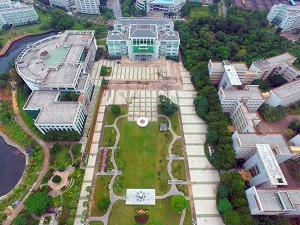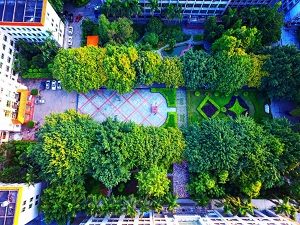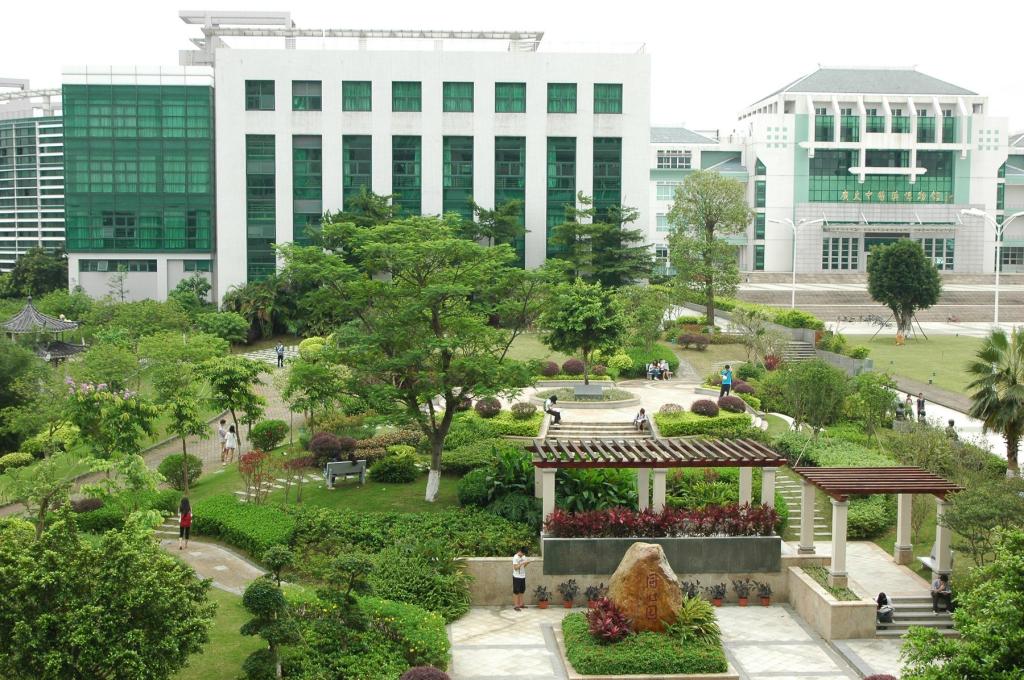Profile
- Founded in: 1956-10-11
- Campus: square meters
- Students: 11391 (as of 18 December)
- International Students: 390 (as of 18 December)
- Scholarship: Yes
Study in Guangzhou University of Chinese Medicine

Established in 1956, Guangzhou University of Traditional Chinese Medicine is one of the first four Chinese medicine universities established in New China. It was directly under the leadership of the Ministry of Health and the State Administration of Traditional Chinese Medicine. It was transferred to the Guangdong Provincial People's Government in 2000. Now it is the key construction university and high-level university construction unit of "211 Project" in Guangdong Province. In 2017, it was selected as the first batch of national "double-first-class" disciplines construction universities. It is one of the two Chinese medicine universities with the first-level disciplines and the only provincial university with the first-level disciplines and national key disciplines. After 60 years of construction and development, the overall school-running level, medical service capacity and international influence of the school rank in the forefront of Chinese medicine colleges and universities in the country.
The school has two campuses, Sanyuanli and University Town, covering an area of 1377 mu, with a construction area of more than 780,000 square meters. There are 1373 full-time teachers, including 384 senior and 458 Vice-Senior titles. There are a number of famous experts and professors represented by Deng Tietao, Yu Guowei and Zhou Daihan. There are 11391 full-time undergraduates, 690 specialists (excluding foreign students), 3767 postgraduates and 966 doctoral students. Sixteen secondary colleges and 27 undergraduate majors spanning seven disciplines such as medicine, science, engineering, management, economics, literature and education; six first-level disciplines such as traditional Chinese medicine, traditional Chinese medicine, integrated traditional Chinese and Western medicine, clinical medicine, pharmacy and nursing; two second-level disciplines such as social medicine and health management, philosophy of science and technology; and three professional degree categories such as traditional Chinese medicine, traditional Chinese medicine and nursing. (field) master's degree authorization points; three first-level disciplines of traditional Chinese medicine, traditional Chinese medicine, integrated traditional Chinese and Western medicine, and one professional degree category (field) doctoral degree authorization points of traditional Chinese medicine; three post-doctoral research mobile stations of traditional Chinese medicine, traditional Chinese medicine and integrated traditional Chinese and Western medicine. There are 1 national key disciplines in the first-level disciplines, 3 key disciplines in Guangdong Province, including 1 Panfeng key disciplines in Guangdong Province and 2 dominant key disciplines in Guangdong Province, 25 key disciplines in Chinese medicine in the State Administration of Traditional Chinese Medicine, and 2 disciplines in clinical medicine, pharmacology and toxicology are among the top 1% of ESI in the world.
 Emphasizing classics and strengthening clinical practice is the most distinctive feature of undergraduate teaching. In the mid-1980s, the school took the lead in launching the teaching reform of classics returning to clinic, including the four classics as compulsory courses in the teaching plan, implementing the management system of "integration of colleges and departments" and promoting the coordinated development of medicine and education. "Focus on classics, strengthen clinical" training mode of high-quality Chinese medicine personnel characteristics"won the second prize of national teaching achievement award in 2014. In 2015, the Ministry of Education decided to be the first batch of colleges and universities to implement the "pilot reform of the education and training plan for outstanding doctors (TCM)" and undertake the "pilot reform project of the model of top innovative talents in TCM". In 2017, it was selected as the second batch of national demonstration universities to deepen innovation and entrepreneurship education reform. In recent years, the passing rate of students participating in the qualification examination of licensed physicians has always been among the highest in Chinese medicine colleges and universities in the country. Degree and postgraduate education began in 1978. It is one of the first universities in China to obtain the right to confer doctoral and master's degrees. The enrollment scale and training quality of Postgraduates rank among the top universities of traditional Chinese medicine in China.
Emphasizing classics and strengthening clinical practice is the most distinctive feature of undergraduate teaching. In the mid-1980s, the school took the lead in launching the teaching reform of classics returning to clinic, including the four classics as compulsory courses in the teaching plan, implementing the management system of "integration of colleges and departments" and promoting the coordinated development of medicine and education. "Focus on classics, strengthen clinical" training mode of high-quality Chinese medicine personnel characteristics"won the second prize of national teaching achievement award in 2014. In 2015, the Ministry of Education decided to be the first batch of colleges and universities to implement the "pilot reform of the education and training plan for outstanding doctors (TCM)" and undertake the "pilot reform project of the model of top innovative talents in TCM". In 2017, it was selected as the second batch of national demonstration universities to deepen innovation and entrepreneurship education reform. In recent years, the passing rate of students participating in the qualification examination of licensed physicians has always been among the highest in Chinese medicine colleges and universities in the country. Degree and postgraduate education began in 1978. It is one of the first universities in China to obtain the right to confer doctoral and master's degrees. The enrollment scale and training quality of Postgraduates rank among the top universities of traditional Chinese medicine in China.
The scientific research work of the school insists on highlighting its characteristics and highlighting its advantages. "Clinical and Experimental Research on spleen deficiency myasthenia gravis" led by Professor Deng Tietao, a master of traditional Chinese medicine, won the second prize in 1992 for national scientific and technological progress; the "series of research on syndrome differentiation and treatment of spleen deficiency" led by Professor Wang Jianhua, a lifelong professor, won the second prize in 2000 for national scientific and technological progress award. Its landmark achievement, "inheritance and innovation of spleen deficiency theory and its applied research" was selected as "Inheritance and innovation of Chinese Medicine Major Theory Inheritance and Innovation Collection; Professor Yuan Hao led the "Research on the Treatment of Femoral Head Necrosis with Integrated Traditional Chinese and Western Medicine" won the second prize of National Science and Technology Progress in 2000. In the prevention and treatment of major infectious diseases in traditional Chinese medicine, schools are brave enough to take the initiative. As a major member unit, the school participated in the national "523" malaria control project, which proved the anti-malaria efficacy of artemisinin in clinic and made a great contribution to the invention of artemisinin. Professor Li Guoqiao's team has won the National Science Congress Award, the National Second Prize for Technological Invention and the National Second Prize for Scientific and Technological Progress. The school focuses on seven platforms: Guangdong Branch of the Chinese Academy of Traditional Chinese Medicine, Guangdong Clinical Research Institute of Traditional Chinese Medicine, South China Synergistic Innovation Center of Traditional Chinese Medicine, South China Acupuncture and Moxibustion Research Center, International Center for TCM Conversion Medicine, Modern South Medicine Engineering Technology Center and Lingnan Medical Research Center. It has 52 research platforms at or above the provincial and ministerial level.
 Based on its own advantages, the school actively participates in the construction of a strong province of traditional Chinese medicine. There are 6 affiliated hospitals (including 2 with the government) and 30 non-affiliated hospitals. There are more than 8000 beds in affiliated hospitals, 12 million outpatients per year and 180,000 discharges per year. The First Affiliated Hospital has become the first pilot unit for innovation of TCM diagnosis and treatment mode and the second batch of "National TCM Clinical Research Base Construction Unit", which is one of the largest hospitals in the regional TCM (specialty) diagnosis and treatment centers in China. The number of outpatient services in the Second Affiliated Hospital ranks first in the country for 20 consecutive years and the first in the "Top 100 Competitiveness List of TCM Hospitals in China" for 4 consecutive years, for 5 consecutive sessions. It has been appraised as the "National Civilization Unit" and is now the first batch of key construction units in the "Peak Climbing Plan" for the construction of high-level hospitals in Guangdong Province. The Third Affiliated Hospital is the only tertiary grade A bone injury hospital in Guangdong Province. During the period of SARS, Deng Tietao, a Chinese physician, was appointed as the head of the anti-SARS Chinese medicine expert group of the State Administration of Traditional Chinese Medicine. He advocated early intervention of traditional Chinese medicine with outstanding clinical effect, which was recognized by experts of the World Health Organization and promoted to the whole country.
Based on its own advantages, the school actively participates in the construction of a strong province of traditional Chinese medicine. There are 6 affiliated hospitals (including 2 with the government) and 30 non-affiliated hospitals. There are more than 8000 beds in affiliated hospitals, 12 million outpatients per year and 180,000 discharges per year. The First Affiliated Hospital has become the first pilot unit for innovation of TCM diagnosis and treatment mode and the second batch of "National TCM Clinical Research Base Construction Unit", which is one of the largest hospitals in the regional TCM (specialty) diagnosis and treatment centers in China. The number of outpatient services in the Second Affiliated Hospital ranks first in the country for 20 consecutive years and the first in the "Top 100 Competitiveness List of TCM Hospitals in China" for 4 consecutive years, for 5 consecutive sessions. It has been appraised as the "National Civilization Unit" and is now the first batch of key construction units in the "Peak Climbing Plan" for the construction of high-level hospitals in Guangdong Province. The Third Affiliated Hospital is the only tertiary grade A bone injury hospital in Guangdong Province. During the period of SARS, Deng Tietao, a Chinese physician, was appointed as the head of the anti-SARS Chinese medicine expert group of the State Administration of Traditional Chinese Medicine. He advocated early intervention of traditional Chinese medicine with outstanding clinical effect, which was recognized by experts of the World Health Organization and promoted to the whole country.
The school actively promotes collaborative innovation and serves the local economy. The school has established cooperative relations with 15 cities and counties both inside and outside the province to help peasants get rid of poverty and prosperity and promote economic development in mountainous areas. Develop all-round and multi-level cooperation with Guangzhou Pharmaceutical Group, Huarun 39, Kangmei Pharmaceutical Industry, Fuxing Pharmaceutical and other famous pharmaceutical enterprises. Weinaian, Guxian Tablets, Xiaoke Pills, Jinfo Zhitong Pills, Zishen Yutai Pills and other series of Chinese patent medicines developed by the school have become the core products of Guangdong pharmaceutical enterprises and have been sold well throughout the country. In the past three years, the school has vigorously developed the transfer of scientific and technological achievements and technology transfer. The contract funds for the transfer of scientific and technological achievements amount to more than 20 million yuan. Sixteen standardized planting bases of traditional Chinese medicines featuring "Nanyao" have been established under the guidance of the whole province, covering an area of more than 200,000 mu.
The school vigorously excavates and promotes the traditional Chinese medicine culture, and shapes the unique humanistic environment of the industry. The Guangdong Museum of Traditional Chinese Medicine built by the school is the first batch of national secondary museums in Colleges and universities in China. Along with the First Affiliated Hospital and the Second Affiliated Hospital, it has been designated by the State Administration of Traditional Chinese Medicine as the first batch of national bases for propaganda and education of traditional Chinese medicine culture, and has become an important window for spreading traditional Chinese medicine culture in Guangdong. The school has compiled and published a number of large-scale books, such as Popular Chinese Medicine Series and Lingnan Traditional Chinese Medicine Library, which have become the key recommended bibliography for the activities of "China Travel of Traditional Chinese Medicine". The school also co-produced 12 large-scale documentary "Hanging Hu Lingnan" with Guangdong Traditional Chinese Medicine Bureau and Guangdong Radio and Television Station.
Schools should give full play to geopolitical and cultural advantages and actively serve the national "one belt and one way" strategy. Since 1974, foreign students have been recruited, and more than 20,000 senior talents of traditional Chinese medicine have been trained for more than 110 countries and regions. The school has been cooperating with Southeast Asian countries and African countries in anti-malaria research. The 4th generation artemisinin series of compound antimalarials with independent intellectual property rights developed by Professor Li Guoqiao's team has been listed as a key project of the construction of strong provinces of traditional Chinese medicine in Guangdong Province and a key foreign cooperation project of the State Administration of Traditional Chinese Medicine, and has been presented as a "national gift" to many African countries. Professor Song Jianping's scientific research team cooperated in the implementation of the artemisinin compound rapid malaria eradication project in the Comoros, effectively curbing the local malaria epidemic and achieving the first zero malaria death in the history of the country, which attracted widespread attention of the international community. Artemisinin has obtained international patent protection in 38 countries, including the United States, and trademark registration in 29 countries. Artemisinin is marketed in 22 malaria-endemic countries. The First Affiliated Hospital and the Icahn Medical College of Mount Sinai in the United States carried out the research on the prevention and treatment of immune diseases with traditional Chinese medicine; the Second Affiliated Hospital and the Karolinska Medical College in Sweden carried out the research on the prevention and treatment of infectious diseases with traditional Chinese medicine, and signed a contract with the Massachusetts General Hospital in the United States to build the Chinese Hospital of Massachusetts General Hospital in Hengqin, Zhuhai; the The Royal Melbourne Polytechnic University of Australia organizes Shenzhen College of Life and Health Engineering. In addition, the school also took the initiative to undertake the project of the China-ASEAN Cooperation Fund of the Ministry of Foreign Affairs, and cooperated with ASEAN countries on higher education of traditional medicine.

